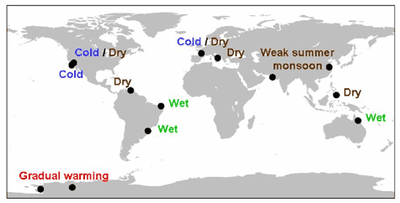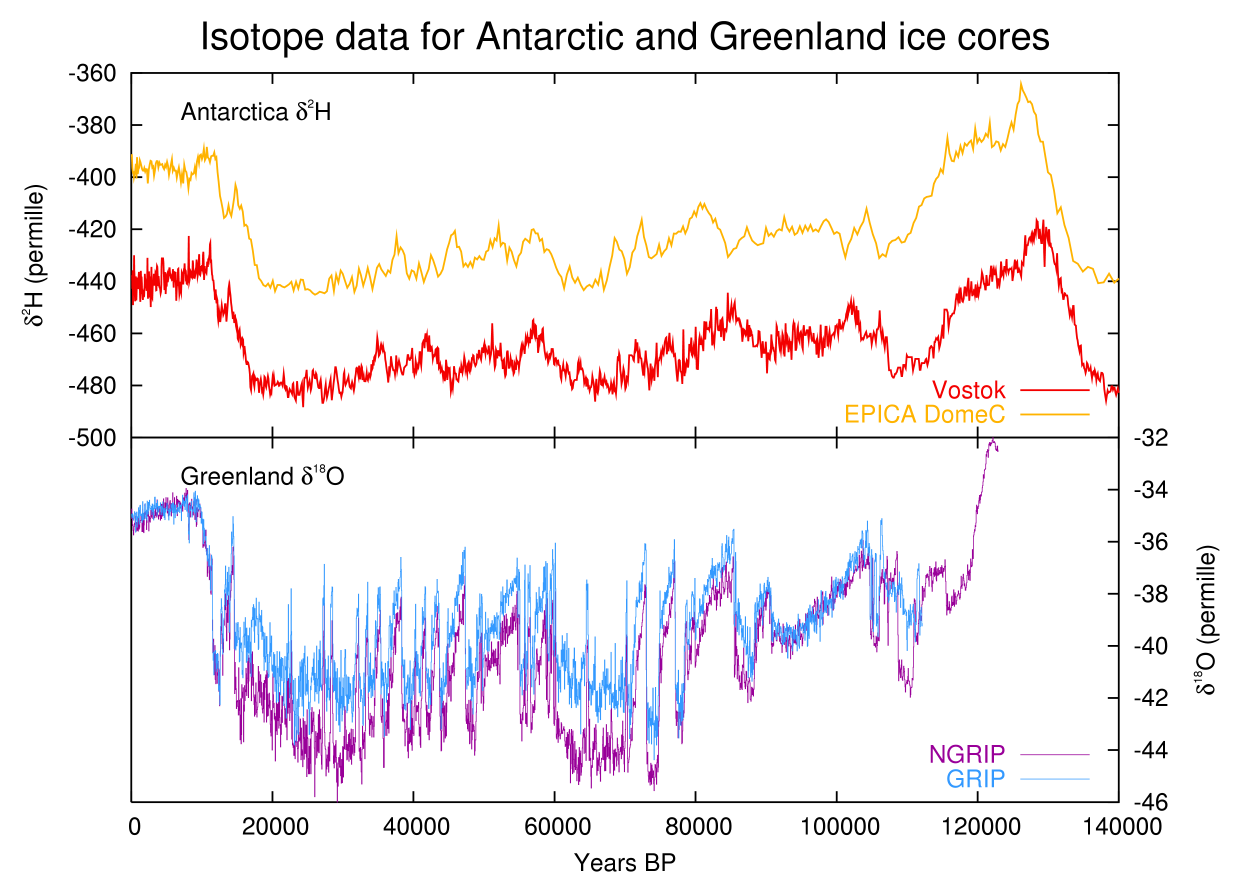Dansgaard Oeschger Events
The (estimated) 1470 Year Climate Cycle – Often quoted as the 1500 year cycle is a popular red herring used by S. Fred Singer and Dennis Avery. It is also a real climate cycle known as Dansgaard-Oeschger (D-O) events. It is of unknown origin.
According to S. Fred Singer and Dennis Avery, our current warming is natural and caused by natural cycles in the earth system. They attribute current warming to what are known as Dansgaard-Oeschger (D-O) events and wrote a book about it called ‘Unstoppable Global Warming’.
S. Fred Singer is also well known for taking a stand contrary to medical evidence that second hand smoke from cigarettes is bad not for you. Funding for his work has been linked to special interests both in the tobacco industry and more recently the fossil fuel industry. Dennis Avery, is an economist.
In their book, by Singer and Avery purport that there is a regular global warming that occurs. Unfortunately they forgot to check the facts, the context, and the relevance. There is a change that occurs, not a warming though; more like a heat exchange. In other words, the D-O events seem to be a part of a seesaw effect that occurs between the hemispheres possibly due to the thermohaline circulation and its capacity to transport heat energy through the ocean. When the Arctic gets cold, the Antarctic warms.
The origins of the driver mechanism are unknown so any claims Singer and Avery might wish to claim are at this time still unfounded. However, evidence indicates that it is a heat exchange and that such a large heat exchange may have its own related climate system feedbacks.
Periodicity
Examination of D-O events shows that they have a periodicity of 1470 years. According to Ramstorf et al, The origin of the pacing remains a mystery.

The δ18O record from the GISP2 ice core in Greenland, showing 20 of the 25 observed Dansgaard-Oeschger events during the last glacial period (Grootes et al., 1993). (Bottom) A record of ice-rafted material during Heinrich events from a deep-sea core in the North Atlantic (Bond and Lotti, 1995).
Related to some of the coldest intervals between D-O events were six distinctive events, named after paleoclimatologist Hartmut Heinrich, that are recorded in North Atlantic marine sediments as layers with a large amount of coarse-grained sediments derived from land (Figure 4). These layers, which are continuous across large areas of the North Atlantic, are evidence for both an increase in icebergs discharged from the Laurentide ice sheet in North America and a southward extension of cold, polar waters (Bond et al. 1992, Bond and Lotti 1995). Icebergs carry sand-sized grains eroded by ice sheets. When icebergs encounter warmer ocean water, they melt and drop their sediment load onto the sea floor. A southward extension of cold, polar waters allowed icebergs to travel farther before melting. Figure 4 shows that Heinrich events occurred less frequently than D-O events. D-O events repeated every several thousand years on average, while ~10,000 years elapsed between Heinrich events. Neither of the two types of events is strictly periodic, however.
What caused Heinrich and Dansgaard-Oeschger events?
The cause of these glacial events is still under debate. Currently, the leading hypothesis involves a slowdown of the ocean’s thermohaline circulation. During the last glacial time, large ice sheets rimmed the North Atlantic (Figure 2). At certain times, these ice sheets released large amounts of freshwater into the North Atlantic. Heinrich events are an extreme example of this, when the Laurentide ice sheet disgorged excessively large amounts of freshwater into the Labrador Sea in the form of icebergs. Scientists have hypothesized that these freshwater dumps reduced ocean salinity enough to slow deepwater formation and the thermohaline circulation. Since the thermohaline circulation plays an important role in transporting heat northward, a slowdown would cause the North Atlantic to cool. Later, as the addition of freshwater decreased, ocean salinity and deepwater formation increased and climate conditions recovered.
This freshwater forcing hypothesis is supported by evidence for changes in deepwater formation. Measurements from deep sea sediments in the North Atlantic indicate that deepwater formation was strongly reduced during Heinrich events (Shackleton et al., 2000; Elliot et al., 2002; McManus et al., 2004). Evidence for reduced deepwater formation between D-O events is somewhat more ambiguous, but it is possible that the North Atlantic branch of the thermohaline circulation was weaker and somewhat shallower at those times (Elliot et al., 2002).
The initial trigger for freshwater releases has not yet been identified. One suggestion is that small, gradual changes in solar output could have influenced the timing of abrupt changes (Bond et al., 2001). Other ideas call upon natural oscillations of the ice sheets themselves (MacAyeal, 1993; Hulbe et al., 2004; Alley et al., 2006) or of ocean processes (Shaffer et al., 2004, Flückiger et al., 2006).

Global climate anomalies during Heinrich events and between Dansgaard-Oeschger events. Compilation by Overpeck and Cole (2006). (Source Link NOAA/NCDC)
Even though Heinrich and D-O events seem to have been initiated in the North Atlantic, they had a global footprint. Some of the best evidence outside of the North Atlantic for these events comes from sediment cores in the Caribbean (Peterson et al. 2000) and Arabian Seas (Schulz et al. 1998), and in speleothems from Hulu Cave in China (Wang et al. 2001). These sites, along with others, are shown in Figure 5. The climate anomalies are consistent with a slowdown of the thermohaline circulation and reduced ocean heat transport into the northern high latitudes. During cold phases in the North Atlantic, large regions of North America and Eurasia became colder and drier. A southward shift of the tropical rain belt moistened many parts of the Southern Hemisphere. Antarctic ice cores show warming, consistent with a reduction of northward heat transport from the Southern Hemisphere.
Links
- https://www.ncei.noaa.gov/sites/default/files/2021-11/2%20Heinrich%20and%20Dansgaard%E2%80%93Oeschger%20Events%20-%20Final-OCT%202021.pdf
- https://www.ncdc.noaa.gov/paleo/abrupt/data3.html
- https://en.wikipedia.org/wiki/Dansgaard-Oeschger_event
- https://www.realclimate.org/index.php/archives/2006/11/avery-and-singer-unstoppable-hot-air/
- https://www.realclimate.org/index.php/archives/2007/06/curve-manipulation-lesson-2/
Additional References
- Richard B. Alley (2000). “Ice-core evidence of abrupt climate changes“. PNAS 97 (4): 1331–1334. doi:10.1073/pnas.97.2.767. PMID 10677460. https://www.pnas.org/cgi/content/full/97/4/1331.
- Bond, G.C.; Lotti, R. (1995–02-17). “Iceberg Discharges into the North Atlantic on Millennial Time Scales During the Last Glaciation”. Science 267 (5200): 1005. doi:10.1126/science.267.5200.1005. PMID 17811441.
- Bond, G.; et al. (1997). “A Pervasive Millennial-Scale Cycle in North Atlantic Holocene and Glacial Climates” (PDF). Science 278 (5341): 1257–1266. doi:10.1126/science.278.5341.1257. https://rivernet.ncsu.edu/courselocker/PaleoClimate/Bond%20et%20al.,%201997%20Millenial%20Scale%20Holocene%20Change.pdf.
- Bond et al. (1999). Bond, G.C., Showers, W., Elliot, M., Evans, M., Lotti, R., Hajdas, I., Bonani, G., Johnson, S., (1999). “The North Atlantic’s 1–2 kyr climate rhythm: relation to Heinrich events, Dansgaard/Oeschger cycles and the little ice age“. in Clark, P.U., Webb, R.S., Keigwin, L.D.. Mechanisms of Global Change at Millennial Time Scales. Geophysical Monograph. American Geophysical Union, Washington DC. pp. 59–76. ISBN 0-87590-033-X.
- Bond, G.; et al. (2001). “Persistent Solar Influence on North Atlantic Climate During the Holocene”. Science 294 (5549): 2130–2136. doi:10.1126/science.1065680. PMID 11739949.
- Maslin, M.; Seidov, D.; Lowe, J. (2001). “Synthesis of the nature and causes of rapid climate transitions during the Quaternary” (PDF). Geophysical monograph 126: 9–52. https://www.essc.psu.edu/~dseidov/pdf_copies/maslin_seidov_levi_agu_book_2001.pdf. Retrieved 2008-03-06.
- Stefan Rahmstorf (2003). “Timing of abrupt climate change: A precise clock” (PDF). Geophys. Res. Lett. 30 (10): 1510. doi:10.1029/2003GL017115. https://www.pik-potsdam.de/~stefan/Publications/Journals/rahmstorf_grl_2003.pdf.
- Braun, Holger; et al. (2005). “Possible solar origin of the 1,470-year glacial climate cycle demonstrated in a coupled model”. Nature 438: 208–211. doi:10.1038/nature04121.
- Schulz, Michael (2002). “On the 1470-year pacing of Dansgaard-Oeschger warm events”. Paleoceanography 17 (2): 1014. doi:10.1029/2000PA000571.
- Voelker, Antje H.L. (2002). “Global distribution of centennial-scale records for Marine Isotope Stage (MIS) 3: a database”. Quaternary Science Reviews 21: 1185–1212. doi:10.1016/S0277-3791(01)00139-1.
Some important datasets related to Heinrich and Dansgaard-Oeschger events:
- Bond et al. (1992), ice-rafted material from marine sediment cores in the North Atlantic
- Grootes et al. (1993), ice core δ18O from GISP2 in Greenland
- Benson et al. (1996), lake sediment data from Owens Lake in California
- Schulz et al. (1998), marine sediment data from cores in the Arabian Sea
- Allen et al. (1999), pollen from Lago Grande di Monticchio in Italy
- Petit et al. (1999), ice core deuterium from Vostok in Antarctica
- Hendy and Kennett (2000), foram data from the Santa Barbara Basin
- Peterson et al. (2000), marine sediment data from the Cariaco Basin
- Blunier and Brook (2001), stable isotopes and trace gases from ice cores in Greenland and Antarctica
- Wang et al. (2001), speleothem δ18O data from Hulu Cave in China
- Stott et al. (2002), marine sediment records from the Western Pacific Warm Pool
- Genty et al. (2003), stable isotopes from Villars Cave in France
- Brook et al. (2005), stable isotopes from Siple Dome in West Antarctica
- Cruz et al. (2005), stable isotopes from Botuvera Cave in Brazil
- Related content
- Natural Cycle
- Natural Variation
- S. Fred Singer

